The Partisans' Grave
by WIESŁAW PASZKOWSKI, Częstochowa Municipal Museum, History Documentation Centre
Edited: ALON GOLDMAN, Chairman of the Association of Częstochowa Jews in Israel English translation: ANDREW RAJCHER

The image of the grave many years ago – today part is difficult to read.
Within the Żydowska Organizacja Bojowa (Jewish Fighting Organisation), there were two suggestions for action. Some fighters favoured defending the “Small Ghetto” in the event of any attempt by the Germans to liquidate it. Others wanted to leave the “Small Ghetto” and conduct a guerrilla fight against the Germans from the forests of Olsztyn and Złoty Potok.
At the beginning of March, five fighters were sent to the forests – Moniek Flamenbaum, Olek Herszberg, Janek Krauze and Heniek Richter (the son of pre-War communist activist Dawid Richter) and Jerzyk Rozenblat. Szlamek Szajn joined the group later. He had long been sought after by the Gestapo.
Initially, they maintained contact with the (communist) Gwardia Ludowa (People’s Guard). Later, their situation became dangerous when they were attacked by a reactionary group of the Armia Krajowa (Home Army). They returned from the forest and barricaded themselves in a bunker of the building at Wilsona 34, where there were stores of old, broken, Jewish furniture. These warehouses belonged to the Möbellager. It was from there, from time to time, that they arranged their “excursions”.
That same building also contained bunkers in which were hidden several Jewish families, including the elderly and children. Among those who were there was the wife of Dawid Kongrecki, together with their two children. Due to the carelessness of the older Kongrecki child, on 17th March 1943, the Gestapo discovered the bunker containing the six young partisans. They were suddenly attacked, leaving them with no time to use their weapons.
Felicja Karay tells the story a little differently:
The Kongrecki family, the mother and her two sons, were hiding in the same building. When, one day, one of the boys went outside, he was caught by a German who beat him until he revealed the hiding-place of the partisans. Surprised by the police, they had no time to use their weapons. It is also possible that they decided not to use them, so as not to reveal the location of the bunkers where the children were hidden. They were thrown into the Gestapo prison. There, they met another Jewish boy who, later, was released and told his parents about the partisans’ last moments. They did not give their real names so as not to endanger their families. On 19th March, after two days of merciless torture, they were taken to the Cemetery and shot.
After the War, the families of those murdered arranged for a cement grave, typical for those years, with the inscription, in Polish:
Here rest six young Jewish partisans who fell fighting for freedom on 19th March 1943
Flamenbaum Moniek age 21
Herszenberg Olek age 26
Krauze Janek age 23
Rychter Heniek age 19
Rozenblatt Jerzyk age 18
Szajn Szlamek age 23
May their memory be honoured.
There is also a second block with the same inscription written in Yiddish.
Over time, the grave has deteriorated (just as have others similarly constructed) or have fallen victim to vandalism. Unfortunately, from 1970, the Cemetery became inaccessible (It found itself within the grounds of a securely guarded industrial plant.) and, after 1989, it lacked any supervision. For this reason, at the end of the 1990’s, Sigmund Rolat decided to move the remains of his brother and his companions to another, more suitable, place. During the exhumation, it turned out that the grave was the resting place of at least seven individuals. Because it was then thought that a mistake had been made and that they were disturbing the wrong grave, the work’s administrator decided to return the remains into the ground. It was only later that he discovered that the truck, which had left the Częstochowa prison with the six partisans, had been stopped along the way by a military policeman who threw in the body of the young Kongrecki boy.
The cement monument was then remade, recreating its original form.
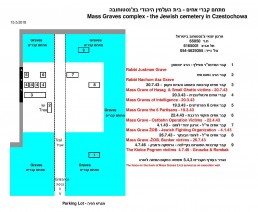
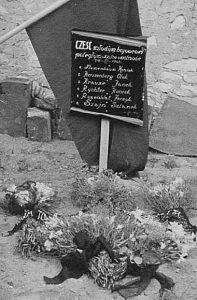 A temporary memorial plaque placed on the partisan grave after the war, until the permanent gravestone was erected.
A temporary memorial plaque placed on the partisan grave after the war, until the permanent gravestone was erected.
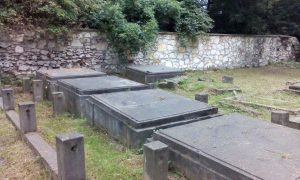 The grave of the six partisans is the solitary grave by the wall. The other four graves in the column are the graves of Czestochowa Jewish intelligentsia.
The grave of the six partisans is the solitary grave by the wall. The other four graves in the column are the graves of Czestochowa Jewish intelligentsia.
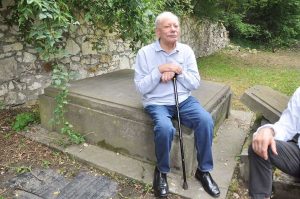 Sigmund Rolat next to the grave of his brother Jerzy – today the face of the gravestone is partly difficult to read.
Sigmund Rolat next to the grave of his brother Jerzy – today the face of the gravestone is partly difficult to read.
FOUR OF THE SIX PARTISANS
(If anyone has photographs of the other two partisans, Alon Goldman would be pleased to received copies of them.)
SZLAMEK SZAJN
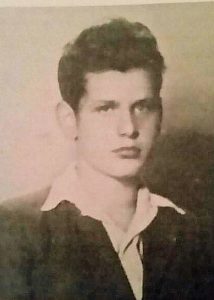 Photo courtesy of the family
Photo courtesy of the family
MOSHE-MONIEK FLAMENBAUM (“Władek”)
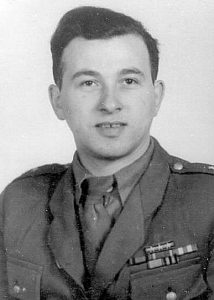 Photo: Ghetto Fighters’ Archive
Photo: Ghetto Fighters’ Archive
JANEK KRAUZE
JERZY ROZENBLATT

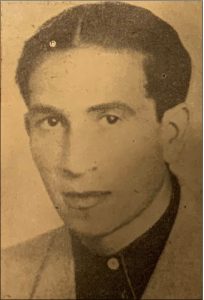
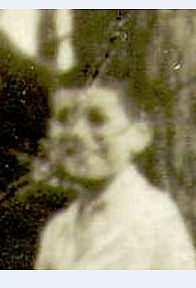
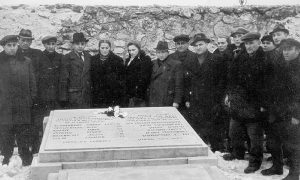 Czestochowa 1946 – a memorial ceremony for the six partisans
Czestochowa 1946 – a memorial ceremony for the six partisans